An Examination of the Chronological Difficulties of
Hoehner and Ice's Calculations of Daniel 9's First 69 Weeks
by Bob Pickle
- Dr. Harold Hoehner's Alternative to Sir Robert Anderson's Dates
- Hoehner's Four Improvements
- Wrong Number of Days Between Dates
- Incorrect Month to Start From
- Sources Cited Prove Error
- Start a Month Later?
- Ignores the Sabbatical Cycle
- Ice's Additional Points
Dr. Harold Hoehner's Alternative to Sir Robert Anderson's Dates
The problems we have discussed
regarding Sir Robert Anderson's dates
for the first 69 weeks of Daniel's 70 weeks are by no means unknown
to dispensational scholars. Dr. Harold Hoehner of the Dallas
Theological Seminary in his 1978 book, Chronological Aspects
of the Life of Christ, published an improvement on Anderson's dates
that solved four of the difficulties. And Dr. Thomas Ice has in the last few years
published a repudiation of Anderson's dates and endorsed Hoehner's
improvements.
But has Hoehner solved all the difficulties?
We first provide a summary of Hoehner's pertinent views on the subject,
taken from Ice's discussion of them at
http://www.pre-trib.org/pdf/Ice-TheSeventyWeeksofDani.pdf.
(Dr. Ice is one of the foremost
scholars and apologists promoting John Darby's doctrine of a pre-trib
secret rapture. He and Tim Lahaye founded the Pre-Trib Research Center
in 1993, an organization dedicated to defending Darby's scenario.)
|
As valuable as Anderson's work continues to be, I believe that it does contain a few errors,
even though this overall approach was a major breakthrough in understanding this part of
Daniel's prophecy. The needed corrections have been provided by Dr. Harold Hoehner of
Dallas Theological Seminary.
Harold Hoehner
Dr. Hoehner has questioned the starting and ending
times put forth by Anderson. Hoehner advocates the time of
Artaxerxes' decree as 444 B.C. and not 445 B.C. Dr. Hoehner explains:
The date of this decree is given in the biblical record. Nehemiah 1:1 states that
Nehemiah heard of Jerusalem's desolate conditions in the month of Chislev
(November/ December) in Artaxerxes' twentieth year. Then later in Artaxerxes'
twentieth year in the month of Nisan (March/April) Nehemiah reports that he was
granted permission to restore the city and build its walls (2:1). To have Nisan later
than Chislev (in the same year) may seem strange until one realizes that Nehemiah
was using a Tishri-to-Tishri (September/October) dating method rather than the
Persian Nisan-to-Nisan method. Nehemiah was following what was used by the
kings of Judah earlier in their history.76 This method used by Nehemiah is confirmed
by the Jews in Elephantine who also used this method during the same time period
as Nehemiah.77
Next, one needs to establish the beginning of Artaxerxes' rule. His father Xerxes
died shortly after December 17, 465 B.C.78 and Artaxerxes immediately succeeded
him. Since the accession-year system was used79 the first year of Artaxerxes' reign
according to the Persian Nisan-to-Nisan reckoning would be Nisan 464 to Nisan 463
and according to the Jewish Tishri-to-Tishri reckoning would be Tishri 464 to Tishri
463. . . .
In conclusion, the report to Nehemiah (1:1) occurred in Chislev
(November/December) of 445 B.C. and the decree of Artaxerxes (2:1) occurred in
Nisan (March/April of 444 B.C.).80
Therefore, Nisan 444 B.C. marks the terminus ad quo of the seventy weeks of
Daniel 9:24-27.81
Dr. Hoehner further objects to Anderson's use of the solar
year instead of the sabbatical year. Dr. Hoehner also corrects
some of Anderson's calculations. Dr. Hoehner spells out his
difference in the following:
First, in the light of new evidence since Anderson's day, the
445 B.C. date is not acceptable for Artaxerxes' twentieth year;
instead the decree was given in Nisan, 444 B.C. Second, the A.D.
32 date for the crucifixion is untenable. It would mean that
Christ was crucified on either a Sunday or Monday.82 In fact,
Anderson realizes the dilemma and he has to do mathematical
gymnastics to arrive at a Friday crucifixion. This makes one
immediately suspect. Actually there is no good evidence for
an A.D. 32 crucifixion date.
In previous chapters in this book it was concluded that
Christ's crucifixion occurred on Friday, Nisan 14, in A.D. 33.
Reckoning His death according to the Julian calendar, Christ
died on Friday, April 3, A.D. 33.83 As discussed above, the
terminus a quo occurred in Nisan, 444 B.C. Although
Nehemiah 2:1 does not specify which day of Nisan the decree
to rebuild Jerusalem occurred, it cannot have occurred before
Nisan 1. . . . it could have occurred on some
other day in Nisan.84
"Using the calculating method Anderson used,
Hoehner comes up with the 476 solar years. This is the
difference between 444 B.C. and A.D. 33. By multiplying
476 by 365.24219879 days, comes to 173,855 days, and
Hoehner states:"85
This leaves only 25 days to be accounted for between 444 B.C.
and A.D. 33. By adding the 25 days to Nisan 1 or March 5 (of
444 B.C.), one comes to March 30 (of A.D. 33) which was Nisan 10
in A.D. 33. This is the triumphal entry of Jesus into Jerusalem. . . .
The terminus ad quem of the sixty-ninth week was on the
day of Christ's triumphal entry on March 30, A.D. 33.
As predicted in Zechariah 9:9, Christ presented Himself to Israel
as Messiah the king for the last time and the multitude of the disciples
shouted loudly by quoting from a messianic psalm: "Blessed is the king
who comes in the name of the Lord" (Ps. 118:26; Matt.21:9; Mark
11:10; Luke 19:38; John 12:13). This occurred on Monday, Nisan 10
(March 30) and only four days later on Friday, Nisan 14, April
3, A.D. 33, Jesus was cut off or crucified. . . .
Dr. Hoehner has put together an airtight case for his
understanding of the beginning and ending of the first
sixty-nine weeks of Daniel's prophecy. . . .
Conclusion
To date, no one has been able to answer the work done by
Dr. Hoehner. It is fully supportive of the literal interpretation
of Daniel's prophecy and is the only approach that has been
demonstrated, thus far, to make the numbers work out. This is why
most all those who take this text literally have adopted Dr.
Hoehner's view. Those taking other views, like preterists Gary
DeMar88 and Ken Gentry,89 offer vague generalities when it comes to the
number of the seventy weeks prophecy.
______________________________________
- Edwin R. Thiele, The Mysterious Numbers of the Hebrew Kings
(rev. ed.; Grand Rapids, 1965), pp. 28-30, 161.
- S. H. Horn and L. H. Wood, "The Fifth-Century Jewish Calendar at Elephantine,"
Journal of Near Eastern Studies, XIII (January 1954), pp. 4, 20.
- Horn and Wood, "Fifth-Century Jewish Calendar," p. 9.
- Horn and Wood, "Fifth-Century Jewish Calendar," p. 4.
- Richard A. Parker and Waldo H. Dubberstein, Babylonian Chronology 626 B.C.-A.D. 75
(2nd ed.; Providence, 1956), p. 32; Herman H. Goldstine, New and Full Moons, 1001 B.C. to
A.D. 1651 (Philadelphia, 1973), p. 47
- Hoehner, Chronological, pp. 127-28.
- J. K. Fotheringham, "The Evidence of Astronomy and Technical
Chronology for the Date of the Crucifixion," The Journal of
Theological Studies, XXXV (April 1934), p. 162.
- See Goldstine, p. 87; Parker and Dubberstein, p. 46;
Fotheringham, The Journal of Theological Studies, XXXV,
pp. 142-62; Joachim Jeremias, The Eucharistic Words of Jesus,
trans. by Norman Perrin (3rd ed.; London, 1966), p. 38.
- Hoehner, Chronological, pp. 137-38.
- Kalafian, Prophecy of the Seventy, p. 89. . . .
- Gary DeMar, Last Days Madness: Obsession of the Modern Church
(Power Springs, GA: American Vision, 1999).
- Kenneth L. Gentry, Jr., He Shall Have Dominion: A Postmillennial Eschatology
(Tyler, TX: Institute for Christian Economics, 1992).
|
Ice and Hoehner are clear:
- Anderson was wrong in saying that the 69 weeks begin in 445 BC instead of 444.
- Anderson was mistaken when he said that they end in 32 AD, for Christ
would then have had to die on a Sunday or Monday.
- Anderson erred in using solar years instead of sabbatical years.
So what should the dates be instead?
- The 69 weeks began on Nisan 1 in 444 BC, which fell on March 5.
- Christ died in 33 AD.
- The 69 weeks ended on Nisan 10, 33 AD, which fell on March 30 that year.
- March 5, 444 BC, and March 30, 33 AD, are 173,880 days apart.
Additionally:
- Daniel should be interpreted literally.
- "No one has been able to answer the work done by Dr. Hoehner."
- Hoehner's approach is "the only approach that" "make[s] the numbers work out."
- By implication, the only interpretation of the 70 weeks that should be considered
is one that makes the numbers work out.
Hoehner's Four Improvements
We note four improvements that Hoehner has made:
- He has correctly identified 444 BC as the 20th year of Artaxerxes.
- 33 AD is a much better choice for the year of the crucifixion,
since it is possible to have Christ die on Friday that year.
- March 5, 444 BC, was likely the first day of a Jewish month,
since the new crescent moon could have first been seen the previous evening.
- March 30, 33 AD, was likely the tenth day of a Jewish month, since the new
crescent moon could have first been seen the evening of March 20.
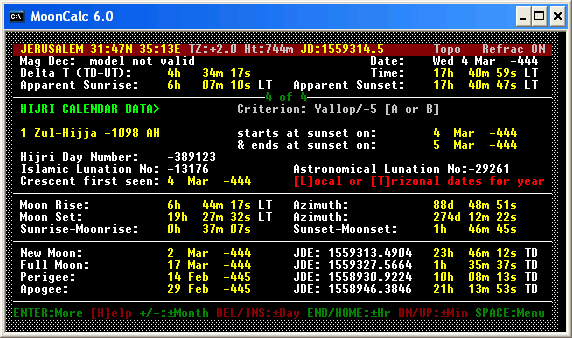 |
|
Figure 1. Using crescent visibility to begin the months,
March 5 was indeed the first day of a Jewish month according to MoonCalc,
unless perchance clouds kept the crescent moon from being seen on the evenings of both March 4 and
February 2. (Since February 2 and March 4 are 30 days apart, and since Jewish months cannot be
longer than 30 days, the evening of March 4 would have begun the new month automatically unless
crescent sighting had been also delayed in February.)
|
|
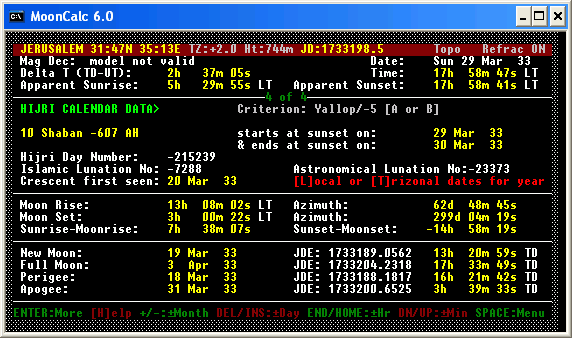 |
|
Figure 2. MoonCalc says that March 30 was indeed the tenth day of the lunar month,
as long as weather conditions did not delay the sighting of the new crescent.
|
|
We now discuss where Hoehner's calculations still fall short.
Wrong Number of Days Between Dates
Similar to Anderson, Hoehner reduced the 483 years
(69 weeks × 7 days per week) to 476.
He first multiplied 483 years by 360 days per year
to arrive at 173,880 days, roughly the number of days
in 476 years.
In order to determine how many days there were between March 5,
444 BC, and March 30, 33 AD, Hoehner multiplied 476 by 365.24219879, the number of days he
thought there were in a year. The difficulty is that, as he himself acknowledges,
he is using Julian dates. That being so, he should have used the figure 365.25,
the number of days in a Julian year. By using 365.24219879 instead of 365.25,
he introduced an error of four days into his calculation.
Instead of there being 173,880 days between the dates in question, there are
really 173,884 days.
Any reader can verify this fact by using a calendar program that computes
Julian Day numbers from Julian dates.
What are Julian Day numbers? A Julian Day number is the number assigned to a date
which tells us precisely how many days have transpired since January 1, 4713 BC, to that date.
For example, January 1, 2005 AD, has a Julian Day number of 2453372, which means that there
have been 2,453,372 days since January 1, 4713 BC. January 2, 2005 AD has a Julian Day number of
2453373, January 3 has a Julian Day number of 2453374, and so on.
A much less confusing method of calculating the exact number of days between
two dates 476 years apart would be to convert those dates to Julian Days,
and then subtract the one from the other. The difference would then represent
the precise number of days between the two.
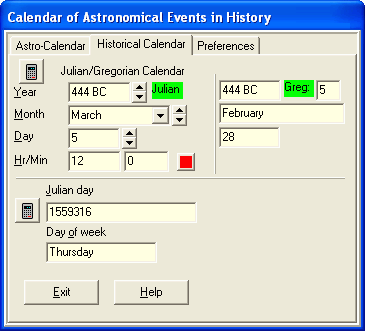 |
|
Figure 3. Above is a snapshot of the Astro-Calendar module of Online Bible,
with some of the extra info trimmed away. Notice that March 5, 444 BC, in the Julian calendar is
February 28 in the Gregorian calendar, and the Julian Day number for that date is 1559316.
|
|
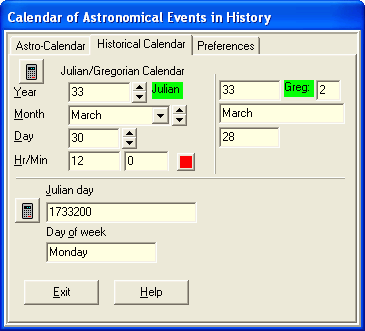 |
|
Figure 4. March 30, 33 AD, in the Julian calendar is March 28 in the Gregorian calendar,
and has a Julian Day number of 1733200.
|
|
Finding the difference between the Julian Day numbers of these two dates, we discover that
the difference between them is actually 173,884 days, not 173,880. Thus, Hoehner was
off by 4 days in his calculation:
| | March 30, 33 AD
March 5, 444 BC |
= Julian Day:
= Julian Day: | |
1733200
− 1559316 | |
 |
| Total Days | | | 173884 |
We recommend that all future calculations of this sort be done by converting to
Julian Day numbers to prevent any further confusion in this important matter.
Incorrect Month to Start From
Admittedly, the wrong number of days between March 5, 444 BC, and March 30, 33 AD,
is not fatal to Hoehner's position, since he correctly states that Artaxerxes could
have sent Nehemiah off to Jerusalem later than Nisan 1. If the correct starting date is Nisan
5 instead of Nisan 1, then the number of days between the dates could be 173,880 after all.
But the difficulty we will consider in this section disqualifies Hoehner's
view from further consideration.
Hoehner postulates a Nisan 1 date occurring on March 5, 444 BC. March 5 that year
corresponds to a Gregorian date of February 28.
One advantage in converting such ancient Julian dates to
Gregorian dates is that we can then get some sort of idea
where the seasons occur in relation to our proposed Jewish dates.
Since the Julian calendar has one leap year every four years,
it gets out of sync with the seasons three days every 400 years.
The Gregorian calendar, on the other hand, skips three leap years every
400 years, and thus stays in sync with the seasons perpetually.
Today's rabbinical Jewish calendar is widely recognized as sometimes having Nisan 1 fall
earlier in the year than it did in Old Testament times and the time of Christ.
Even so, it never starts Nisan 1 on February 28. In 1994, Nisan 1 fell on March 13,
and that's about the earliest it gets in today's rabbinical calendar.
If we project today's rabbinical calendar back to the fifth century BC, we find that
Nisan 1 began on the Julian date of April 2, which corresponds to a Gregorian
date of March 28. Thus, using today's too-early Jewish calendar projected
back to 444 BC, we end up with a date for Nisan 1 a whole month later than
the date postulated by Hoehner.
Sources Cited Prove Error
To support the idea that "Nisan" is "March/April of 444 B.C.,"
footnote 80 in Ice's paper cites "Richard A. Parker and Waldo H. Dubberstein,
Babylonian Chronology 626 B.C.-A.D. 75 (2nd ed.; Providence, 1956), p. 32."
But this is misleading, for when we turn to page 32 of this work,
we find that March 4 marked the first day of Adar (the twelfth Jewish month), while
Nisan 1 fell on April 3. In other words, according to the very source cited to
prove that Nisan began in March, Nisan did not begin until April.
Footnotes 77-79 refer to a 1954 paper by S. H. Horn
and L. H. Wood, published in Journal of Near Eastern Studies.
This paper is an analysis of fourteen double-dated Jewish papyri
from Elephantine, Egypt, which attempts to ascertain the nature of
the Jewish calendar in the fifth century BC. Because the papyri were dated in
both the Jewish calendar and the Egyptian calendar, and because those double
dates can only coincide in particular years and particular months, it is possible
to assign definite dates to these documents to within a day. The Julian dates assigned to these papyri
in the article, along with the dates of the preceding Nisan 1, appear in the table below:
| Jewish Date of Papyrus |
Julian Date of Papyrus |
Preceding Nisan 1 |
| Elul 18 |
Sept. 12, 471 BC |
Apr. 1, 471 BC |
| Kisl. 18 |
Jan. 2, 464 BC |
Apr. 24, 465 BC |
| Siv. 20 |
July 7, 451 BC |
Apr. 20, 451 BC |
| Tam. 18 |
July 13, 449 BC |
Mar. 29, 449 BC |
| Kisl. 2 |
Nov. 19, 446 BC |
Mar. 26, 446 BC |
| Ab 14 |
Aug. 27, 440 BC |
Apr. 18, 440 BC |
| Elul 7 |
Sept. 15, 437 BC |
Apr. 14, 437 BC |
| Tish. 25 |
Oct. 30, 434 BC |
Apr. 12, 434 BC |
| Siv. 20 |
June 12, 427 BC |
Mar. 26, 427 BC |
| Tam. 8 |
July 11, 420 BC |
Apr. 7, 420 BC |
| Kisl. 3 |
Dec. 16, 416 BC |
Apr. 23, 416 BC |
| Sheb. 24 |
Feb. 11, 410 BC |
Mar. 28, 411 BC |
| Mar. 24 |
Nov. 26, 404 BC |
Apr. 10, 404 BC |
| Adar 20 |
Mar. 9, 402 BC |
Mar. 30, 403 BC |
The Elephantine papyri give us Julian dates for Nisan 1 ranging from March 26 through
April 24. Hoehner's proposed date of March 5 for Nisan 1 in 444 BC is therefore as much as three
weeks earlier than the earliest Nisan 1 in the Jewish colony at Elephantine, Egypt. We can therefore
confidentally conclude, based on the very sources that Hoehner cites, that March 5 in 444 BC was
roughly the first of either Adar or Adar II.
Start a Month Later?
Since March 5 is a month too early to be Nisan 1, if we still want to explore
444 BC as a possible starting date for the 69 weeks, we need to try starting with
the Jewish month that began in April instead. On the evening of April 2, the new
crescent moon should have been easily visible, making Nisan 1 coincide with April 3. Since
we already discovered that we likely need to commence on Nisan 5 instead of Nisan 1,
we therefore will start with April 7, which has a Julian Day number of 1559349.
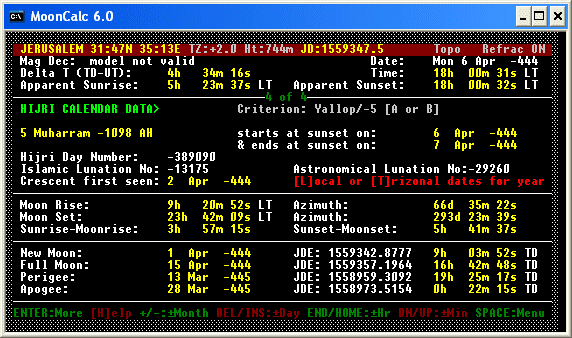 |
|
Figure 5. Based on crescent visibility to begin the months,
April 7, 444 BC, should have been Nisan 5 if weather conditions had allowed the new crescent to be
seen on the evening of April 2.
|
|
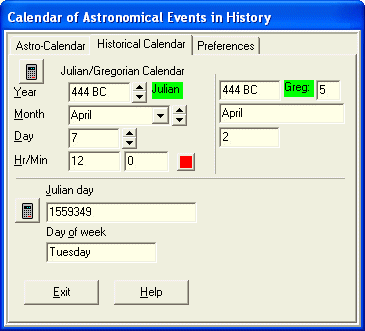 |
|
Figure 6. April 7, 444 BC, in the Julian calendar corresponds to April 2 in the
Gregorian calendar, and the Julian Day number for that date is 1559349.
|
|
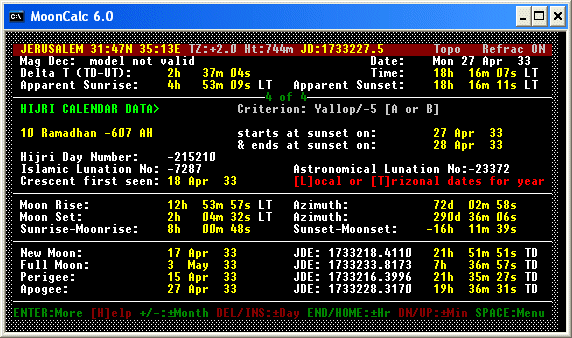 |
|
Figure 7. April 28 could have been Nisan 10 in 33 AD if weather
conditions had been perfect the evening of April 18.
|
|
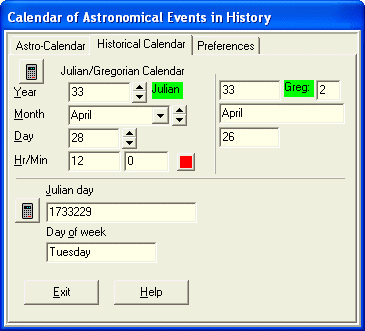 |
|
Figure 8. Tuesday, April 28, 33 AD, in the Julian calendar is April 26 in the Gregorian calendar,
and has a Julian Day number of 1733229.
|
|
Adding 173,880 days to 1559349, we arrive at the Julian Day number of 1733229,
which corresponds to Tuesday, April 28, 33 AD, as a possible Nisan 10:
| |
April 7, 444 BC
|
= Julian Day:
|
|
1559349
+ 173880 |
|
 |
| April 28, 33 AD | = Julian Day: | |
1733229 |
If conditions were perfect on the evening of April 18, 33 AD, the crescent could have been seen and Nisan
could have commenced on April 19, making Tuesday, April 28 indeed Nisan 10.
Otherwise, the start of Nisan would have been delayed
till perhaps April 20, making Nisan 10 fall instead on Wednesday, April 29.
If Nisan 10 fell on a Tuesday or Wedneday in 33 AD, then Nisan 14 had to fall on a Saturday or
Sunday. Since this does not allow Christ to have died on a Friday, or a Wednesday for that matter, a 33 AD
date for the crucifixion is impossible when we try to start a month later in 444 BC.
Thus, Hoehner's reckoning of the 69 weeks, though a definite improvement over Anderson's
dates, is still impossible.
Ignores the Sabbatical Cycle
Similar to Anderson's theory, Hoehner's calculations ignore Jewish sabbatical-year cycles,
but they are by no means alone in doing so. Though it has often been noted that Daniel 9
alludes to the Jewish sabbatical cycles, there have been few attempts to make the 70 weeks
align with them.
The sabbatical year system was mandated in Leviticus 25. In that system, agricultural pursuits
were to be put on hold every seventh year. Israel was explicitly told that if they did not let the
land rest in that seventh year, the land would become desolate and they would be taken captive.
The length of time of desolation and captivity would correspond to the number of sabbatical years
that they had not kept (Lev. 26: 34, 35).
Jeremiah later specified that the Jews would be captives in Babylon for 70 years (Jer. 29:10),
and this 70 years of desolation is explicitly said by the writer of 2 Chronicles to correspond
to the number of sabbatical years that had not been kept (36:21). Therefore, Daniel's reference
to 70 years of desolation in Daniel 9:2 implies a time period of 490 years, for that is the precise number
of years in 70 sabbatical cycles.
It is apparent, then, that Daniel 9 begins with a reference to 490 years or 70 sabbatical cycles,
and ends with a reference to 490 years or 70 sabbatical cycles. It therefore behooves us,
if at all possible, to make our calculations of Daniel's 70 weeks align with actual sabbatical cycles.
Jewish years always stay aligned with the seasons, for the Passover has always occurred in the spring. It never
has occurred in the fall. Thus, there is no possible way to make Hoehner's calculations align with actual sabbatical
cycles. Because he is using a 360-day year instead of a true Jewish year, the Passover falls back 5¼ days
a year and an entire month every six years. In only 35 years, the Passover would occur in the fall, about
six months earlier. Every 70 years, the Passover would have circled all the way through the seasons back to
where it started.
The only possible way to make Daniel's 70 weeks line up with actual sabbatical cycles is to use real
Jewish years that stay aligned with the seasons. Such years must on average be 365.2425 days in length, not 360.
Ice's Additional Points
Let's return to the four additional points we gleaned from Ice's document:
1. Daniel should be interpreted literally.
Absolutely agreed. There's no other way to do it.
2. "No one has been able to answer the work done by Dr. Hoehner."
This may be true if one only consults theologians untrained in pre-1582 AD history
or archaeology. However, any chronologist or archaeologist or historian
familiar with the workings of the Julian calendar would immediately notice
the four missing days in Hoehner's calculations. Additionally, many Jews and Jewish historians
would immediately notice that his proposed date for Nisan 1 in 444 BC is a month too early.
3. Hoehner's approach is "the only approach that" "make[s] the numbers work out."
In actually, there is another approach that makes the numbers work out, without all the
mathematical and chronological problems that accompany Hoehner's theory. And some of the very
writers Hoehner cites believed that this other approach was the correct one.
To prove that the twentieth year of Artaxerxes was 444 BC instead of 445 BC,
Hoehner cites the work of Edwin Thiele, Siegfried Horn, and Lynn Wood (footnotes 76-79).
As Seventh-day Adventists, these three scholars believed, like Sir Isaac Newton before them,
that the 70 weeks began with the seventh year of Artaxerxes in 457 BC and ended in 34 AD.
In fact, the whole purpose of Horn and Wood's work was to provide scholarly support for the
457 BC date of Ezra 7 by proving when fifth-century BC Jews began the reign of Artaxerxes.
There are many advantages to this interpretation, a diagram of which appears below.
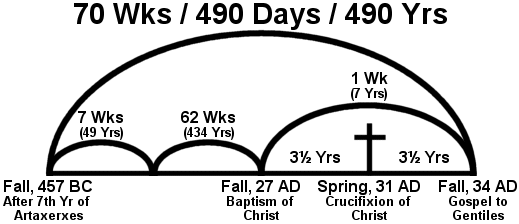
Here is a summary of some of the advantages of this interpretation:
- It uses real Jewish years, which average about 365.25 days in length, and thus does not reduce the
483 years down to 476.
- Because of this, it is not burdened by the necessity of finding two dates that are exactly 173,880
days apart. One only needs to find dates that occur in the right year and season, not that occur
an exact number of days apart.
- This interpretation commences the prophecy immediately after the completion of the decree to restore
and build Jerusalem, not 13 years later:
- The principal reason given by futurists for using the 20th year of Artaxerxes as the starting point
for the 70 weeks is that Cyrus did not command the building of the city. However, according to
Isaiah 44:28; 45:13, Cyrus did indeed command the building
of Jerusalem, and this interpretation does not ignore that fact.
- Ezra 6:14 speaks of Cyrus, Darius, and Artaxerxes issuing a single decree, as if Cyrus
began the process, Darius affirmed it, and Artaxerxes completed it.
- Isaiah 1:26 predicted that the judiciary would be "restored," using the very same Hebrew word
that is translated "restore" in Daniel 9:25. Artaxerxes' unique contribution to the
commandment process was that he fully restored the judiciary by the decree of his seventh year, giving
Jerusalem full authority to enforce the law of God (Ezra 7:25, 26).
- Ezra arrived in Jerusalem in the fifth month, and the judges were at work by the tenth
month (Ezra 7:8, 9; 10:14, 16). This means that the judiciary was restored sometime between the fifth and
tenth months in the fall of 457 BC. Somewhere around that time would be the proper starting point for
the 70 weeks.
- The interpretation that commences the 70 weeks in the fall of 457 BC aligns them with
actual sabbatical cycles:
- Historical records indicate that a new sabbatical cycle began in the fall of 457 BC
("When Were the Sabbatical Years?").
- According to Jewish tradition, a new sabbatical cycle began in the fall after Ezra arrived at
Jerusalem in Artaxerxes' seventh year (Maimonides, Sabbatical and Jubilee Years, ch. 10, par. 3).
- It points to a specific event in Christ's life, His baptism, as being the fulfillment of the words
"unto Messiah the Prince" (Dan. 9:25):
- "Messiah" and "Christ" both mean "the Anointed one," "Messiah" being Hebrew and "Christ" being Greek.
- Christ was anointed with the Holy Spirit (Acts 10:38).
- This anointing of the Spirit occurred at His baptism (Lk. 3:22; 4:1).
- It harmonizes with a possible date for Christ's baptism, the fall of 27 AD:
- Christ's baptism occurred in the 15th year of Tiberius, according to Luke 3:1.
- Tiberius took over after the death of Augustus, who died on August 19, 14 AD.
- If Luke used both non-accession-year reckoning and a fall-to-fall calendar, then the
first year of Tiberius would have commenced at his accession and ended a month or two later
on Tishri 1, 14 AD.
- If Luke began Tiberius' second year in the fall of 14 AD on Tishri 1, then Tiberius' 15th
year would have commenced 13 years later in the fall of 27 AD.
- The death of Herod the Great is said to have been in 4/3 BC. Luke says that at Christ's baptism He was
"about thirty years of age" (3:23), which He was in 27 AD, having been born a little
prior to Herod's death.
- It harmonizes with a possible date for Christ's crucifixion, the spring of 31 AD:
- Depending on the particular position a person has, Christ would be able to die on a Friday
if Nisan 14 that year fell on a Thursday or Friday.
- Depending on the crescent visibility criteria one uses, Nisan 14 could have fallen
on either a Wednesday or a Thursday, if sighting of the crescent was not delayed. Those scholars who
believe that Nisan 14 in the crucifixion year fell on Thursday would agree that this allows Christ to die
on a Friday that year.
- If weather conditions were poor, or if there was some sort of ritualistic postponement of a single day similar
to what can happen in today's Jewish calendar, then Nisan 14 would have fallen on a Friday. Scholars who hold to
the idea that Nisan 14 in the crucifixion year fell on Friday would agree that this allows Christ to die on Friday.
(A postponement of a day might also require that the previous two months also be postponed by a day, since
the Jewish months ending in both March and April would possibly already have 30 days.)
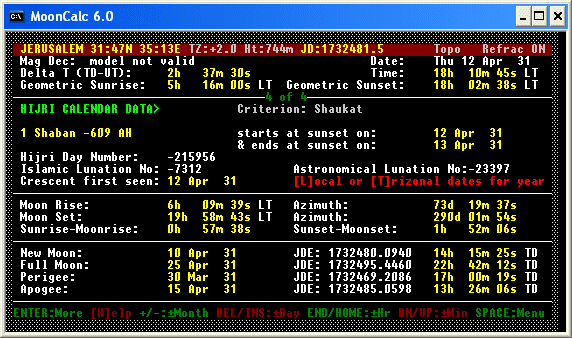 |
|
Figure 10. The above snapshot of MoonCalc shows that Nisan 1 would have fallen on Friday,
April 13, if one uses Shaukhat's criteria for crescent visibility. Other criteria that also yield a date
of the evening of April 12 for the crescent to be seen include Fotheringham and RGO 67.
|
|
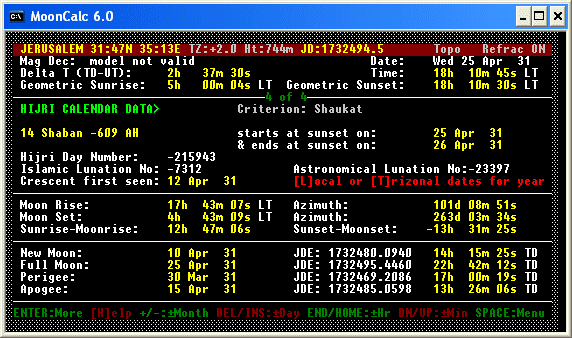 |
|
Figure 11. If Nisan 1 fell on Friday, April 13, then Nisan 14 fell on Thursday, April 26.
Poor weather conditions on the evening of April 12, or a ritualistic postponement rule similar to that of
the modern Jewish calendar could postpone Nisan 1 by one day. Either scenario, whether Nisan was postponed
or not, allows Christ to die on a Friday.
|
|
- This interpretation provides a clear ending point for the 70 weeks: the stoning of Stephen,
which represents the final rejection of the Messiah's covenant by the Jewish nation.
Other points may be added to this list as time permits.
4. By implication, the only interpretation of the 70 weeks that should be considered
is one that makes the numbers work out.
We wholeheartedly agree, and invite everyone to adopt the
position that the 70 weeks commence in 457 BC and end in 34 AD,
with Christ's death occurring in the middle of the 70th week.
|













